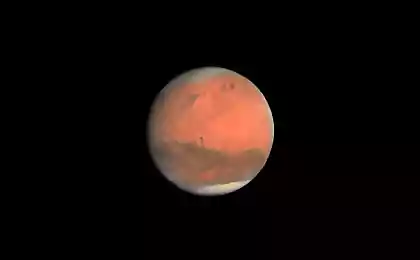1138
Timekeeping on Mars
The problem of synchronization of clock and calendar on Earth and on Mars rose sharply enough, when the era of Mars exploration guns because it was necessary to know precisely the flow of solar energy over as days and years on Mars. In this article I propose to examine the existing methods of timing on Mars.
Since the inclination of the axis of rotation of Mars to the orbital plane differs little from the earth (23 ° 26'21 '' (Earth) and 25 ° 11'24 '' (Mars)), it undergoes a similar seasonal periods, but as the eccentricity of the orbit of Mars is much larger , the duration of the periods are quite different. Also, if a Martian day close in length to the earth, the duration of the year is different, which further enhances the de-synchronization between the calendars.
Day on Earth and Mars h5>
Year on Earth and Mars h5>
Calendar h5>
Since the inclination of the axis of rotation of Mars to the orbital plane differs little from the earth (23 ° 26'21 '' (Earth) and 25 ° 11'24 '' (Mars)), it undergoes a similar seasonal periods, but as the eccentricity of the orbit of Mars is much larger , the duration of the periods are quite different. Also, if a Martian day close in length to the earth, the duration of the year is different, which further enhances the de-synchronization between the calendars.
Day on Earth and Mars h5>
There are two kinds of day - star (sidereal) day duration 23 hours 56 minutes 4 seconds or 09 86164, 09 seconds, and the mean solar day lasting 24 hours or 86400 seconds. They are not equal to each other, because one day, due to the orbital motion of the Earth the sun shifts to the background stars. The average solar day attached to "fictitious sun" because the velocity of the Earth in its orbit, and hence the duration of the true solar day change throughout the year.
For Mars corresponding periods up to 24 h 37 min 22.66 s (88 642, 66) and 24 h 39 min 35.24 s (88 775, 24), respectively. As a simple calculation shows that the length of the sidereal day on Mars 2, 9% more than the Earth, and the length of the solar day by 2, 7%.
By international agreement, for devices operating on the surface of Mars, taken by the so-called "Martian solar day" (Saul) divided into 24 "martian hour". Accordingly, the standard of "Martian seconds" on 2, 7% longer than Earth's. This leads to the fact that operators schedule daily shifts for 40 minutes, and they are at the hands of a specially designed watch with a "Martian time." There are also other projects Martian hours. One of them offered to introduce a metric on Mars time, setting 10 hours a day, 100 minutes per hour and 100 seconds in a minute, on the other - introduced shortened the 25th hour, the duration of 39 minutes 35.24 seconds, but these options were rejected. Account Sols for spacecraft began with Sol 0 for missions Viking, Mars Phoenix and MSL Curiosity and Sol 1 for Mars Pathfinder, MER-A Spirit and MER-B Opportunity.
Zero meridian Mars passes through a small crater Airy-0 which has the coordinates of 5 ° 06'59.99 "S. w. and 0 ° 00'00 "in. d. On Mars applied planetocentric standard longitude at which longitude varies from 0 ° to 360 ° E Old planetographic standard (0 ° to 360 ° W) is used on flat maps.
Coordinated Martian time (Coordinated Mars Time, MTC) is an analog universal time (Universal Time, UT). It is defined as the mean solar time at the prime meridian. Designation MTC can be misleading about the similarity with the standard UTC, however, MTC does not use leap seconds coordination, and the closest terrestrial analogue MTC is standard UT1. Due to the large orbital eccentricity and inclination of the axis of the other, the difference between the true solar time (WIS / LTST) and mean solar time (CER / LMST) changes during the year is much stronger than on Earth. If the world equation of time (HC = WIS - CER) ranges from "minus 14 minutes 22" to "plus 16 minutes 23 ', on Mars the difference is between" -50 minutes "to" plus 40 minutes "that already done. In the domestic literature often used reverse difference (HC = CER - WIS). However, it should not be confused with solar time, lap time, which is associated with the sun just formally. Time zone, in the usual form on Mars is not, and five of the six rovers are local solar time (LMST), and sixth (Mars Pathfinder) uses a true solar time (LTST).
The standard first appeared in the MTC program Mars24Sunclock, created by the Goddard Institute, replacing the standard AMT (Airy Mean Time), the former direct analogue outdated standard GMT. Standard AMT in any of the missions is not being used because of its lack of precision. However, now that there are clear and precise maps of Mars, the standard AMT may again become relevant.
For ease of astronomical calculations in the world used the so-called Julian date (JD), where the zero point accepted on 1 January 4713 Mr. BC. e the Julian calendar, or what is the same, November 24 4714 BC. e. Gregorian calendar. The first day was the number 0. Dates replaced at midday. Similar data for Mars is set to coincide with hydrochloric December 29, 1873 (the date of the birth of astronomer Carl Otto Lampland first effected astrofotosemku blessed memory channels on Mars). In other embodiments of reference were 1608 g (the invention of the telescope) and the spring equinox April 11, 1955.
Year on Earth and Mars h5>
As previously done with the concept of the day to determine the order that this year.
Star (Sidereal) year - the period of the orbital motion around the sun relative to the "fixed stars»;
Tropical year - the period of a complete change of the seasons or period during which the longitude of the Sun varies by 360 ° exactly.
These periods vary honey is about 20 minutes (less than stellar tropical) due to gyroscopic processes such as precession and nutation axis planets.
The duration of one revolution of Mars around the Sun is about 686, 98 solar Earth days, or 668, 59 Sols. Since the eccentricity of the orbit of Mars (0, 0934) is significantly larger than the Earth (0, 0167), if we take the seasonal period between the equinoxes and solstices, the longest season in the northern hemisphere will spring (193 Sola), and the shortest autumn (142 Sola) .
Just as on Earth on Mars best option for the base calendar year is tropical, as the precession cycle on Earth and on Mars are large enough so that they can be neglected in a relatively short time. The length of the tropical year depends on the choice of starting point. Normally, as a point of choosing the equinox or solstice. But usually, the Gregorian calendar is used for the spring equinox. Since the orbit of Mars Bole pulled, the differences in the length of the tropical year is slightly larger than Earth. If the Earth is different third decimal (from 365 in 2416 to 365 days, 2427 days), then Mars is significantly different for the second character (from 668.5880 to 668.5958 hydrochloride salts).
Calendar h5>
In everyday life we use the Gregorian calendar, not the Julian date, for the simple reason that the cyclic calendar is much more convenient and useful in everyday life. And so the future of Martian colonies need is a cyclical calendar. One of the main problems of any calendar intercalation visokosov. It is connected with the fact that the year is not a whole number of days and if you do not take into account the correction for this, very quickly accumulates error between the civil calendar and the tropical year. A variant of this calendar is a calendar created dariysky aerospace engineer and political scientist Thomas Gangale. This calendar consists of 24 months for 27-28 days and is based on a ten-year cycle, with six for leap years 669 days and four of the usual 668. This calendar gives an error of 1 Salt for 100 years and is well suited for the present purposes. However, to date neither the calendar nor any other is not used, the account is only for Sola.
Source: habrahabr.ru/post/215387/
The prosecutor's office in Surgut preparing materials to be condemned man for 4 years for the purchase of smart hours
Robot, played well in table tennis: the development of Germany























